《君子胸怀天地远 亮节操守白云高 书法家专访》
- 2020-10-16 14:25:09
- 点赞量:10920
- 点击量:277100
- 作者:郝连成 Hao Liancheng
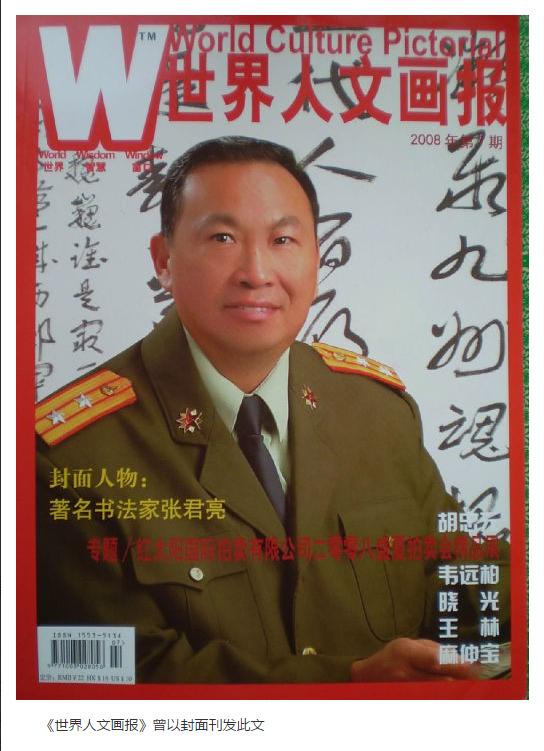
1995年全国第六届书法篆刻展览会上,一个名不见经传的军人有两幅不同风格的书法作品同时入展,一下子使这次国家级规模的大展爆出了亮点。使当时关注中国书法艺术的各家媒体都聚焦到了中国人民解放军65453部队后勤部中校副部长张君亮身上。
At the sixth national calligraphy seal cutting exhibition in 1995, a soldier who was not known to have two calligraphy works of different styles entered the exhibition at the same time, which suddenly made the national scale exhibition highlight. All media concerned about Chinese calligraphy art at that time focused on Zhang Junliang, Vice Minister of the Logistics Department of the 65453 army of the people's Liberation Army.
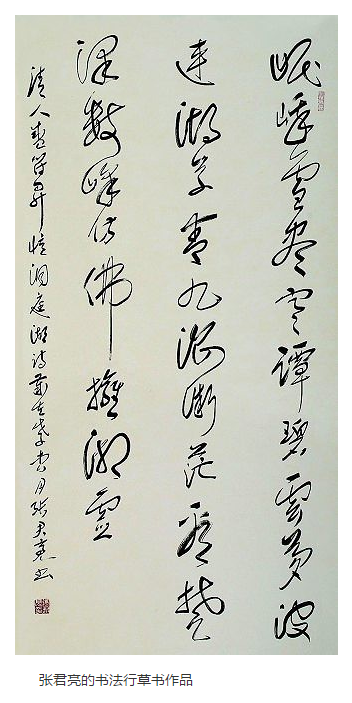
张君亮1962年3月生于山东省成武县郊的一个农村。这里行政隶属牡丹之乡的荷泽地区。秦时设县,汉武帝刘邦因在此地成就“武功”而得名。可能是历史的遗风,这里的人们从小尚武,张君亮在18岁那年走入军营在人们的眼里也就甚为平常了。
Zhang Junliang was born in March 1962 in a rural suburb of Chengwu County, Shandong Province. This administrative branch is the hometown of peony in Heze area. When Qin Dynasty set up a county, Liu Bang, the emperor of Han Dynasty, was named for his achievement of "martial arts" here. It may be the legacy of history. People here are young martial arts. Zhang Junliang was very common in people's eyes when he was 18.
当地风俗,在小孩子出生百天时,在小孩子的身边放上铜钱、算盘、木枪、小锄镐、针线、纸笔之类的物品让小孩子抓福,通过抓福来预测孩子将来的发展方向。那天在众多的物件中,小君亮张开小手抓挠了好几回,最后抓起了一支家里春节时写对联的秃毛笔。全家人好不高兴,这家伙长大不会像我们一样抡撅头种地了。
Local customs: when a child is born for a hundred days, it is necessary to put copper money, abacus, wood gun, pickaxe, needle line, paper pen and other things around the child to make children grasp the blessings, and predict the future development direction of children by grasping blessings. That day in many objects, xiaojunliang opened his hand to scratch several times, and finally grabbed a home Spring Festival writing couplet bald brush. The family is not happy. This guy will not grow up to be like us to pout his head and plant the ground.
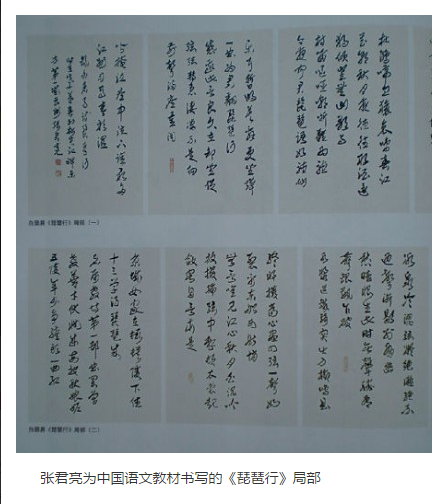
果然,小君亮从小就爱写毛笔字,念初中时就开始给家乡的左邻右舍写对联了。虽然那时他的字在乡亲们的眼里不错。但真正使他从写毛笔字转到书法概念上还是当兵后的一次部队搞的军地书法展览上。部队首长知道他会写毛笔字就让他写会标。结果这幅会标让各地来的书法家好顿的评论:说这哪叫书法展览的会标。一点也没有书法艺术的味道。从那以后张君亮发狠要学习真正的书法,练成书法名家。
Indeed, xiaojunliang loved to write brush words since he was a child. When he was in junior high school, he began to write couplets to his hometown's left and right neighbors. Although his words were good in the eyes of the villagers. But it was a military calligraphy exhibition that was carried out by the army after he was in the army. The chief of the army knew that he could write the writing of the brush and asked him to write the monogram. As a result, the monograph made calligraphers from all over the world have a good comment: which is the emblem of calligraphy exhibition. There is no taste of calligraphy at all. Since then, Zhang Junliang has been ruthless in learning real calligraphy and practicing it as a famous calligrapher.
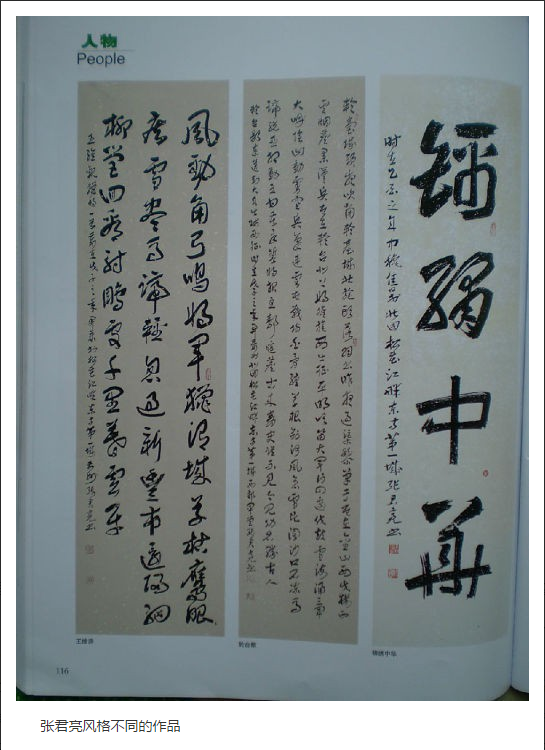
十几年里,他反复地临写了从殷商甲骨文到晚清民国时期上百种风格的碑贴。又不断地游历中国的名山大川,拜访当代的书法名家。从他们的身上直接吸取中国书法的精华。在他的书架上,摆满了与书法和文字有关的书籍,有《中国书法大字典》《中国书法全集》《中国草书大字典》《中国篆刻大字典》以及各个历史时期的名家碑贴和书法期刊。张先生说他从当兵拿津贴到挣工资的钱基本上都花在书法方面的投资了。
In the past decade, he repeatedly wrote hundreds of style steles from Oracle Inscriptions of yin and Shang Dynasties to the period of late Qing Dynasty and the Republic of China. And I have been traveling to the famous mountains and rivers of China and visiting the famous calligraphers of the present age. From them, China can absorb the essence of Chinese calligraphy. On his bookshelf, there are books related to calligraphy and writing, including the Chinese calligraphy dictionary, the Chinese calligraphy collection, the Chinese herbal dictionary, the Chinese seal cutting dictionary, and the famous tablet stickers and calligraphy periodicals in various historical periods. Mr. Zhang said that his money from getting subsidies to making wages from the army was basically spent on calligraphy.
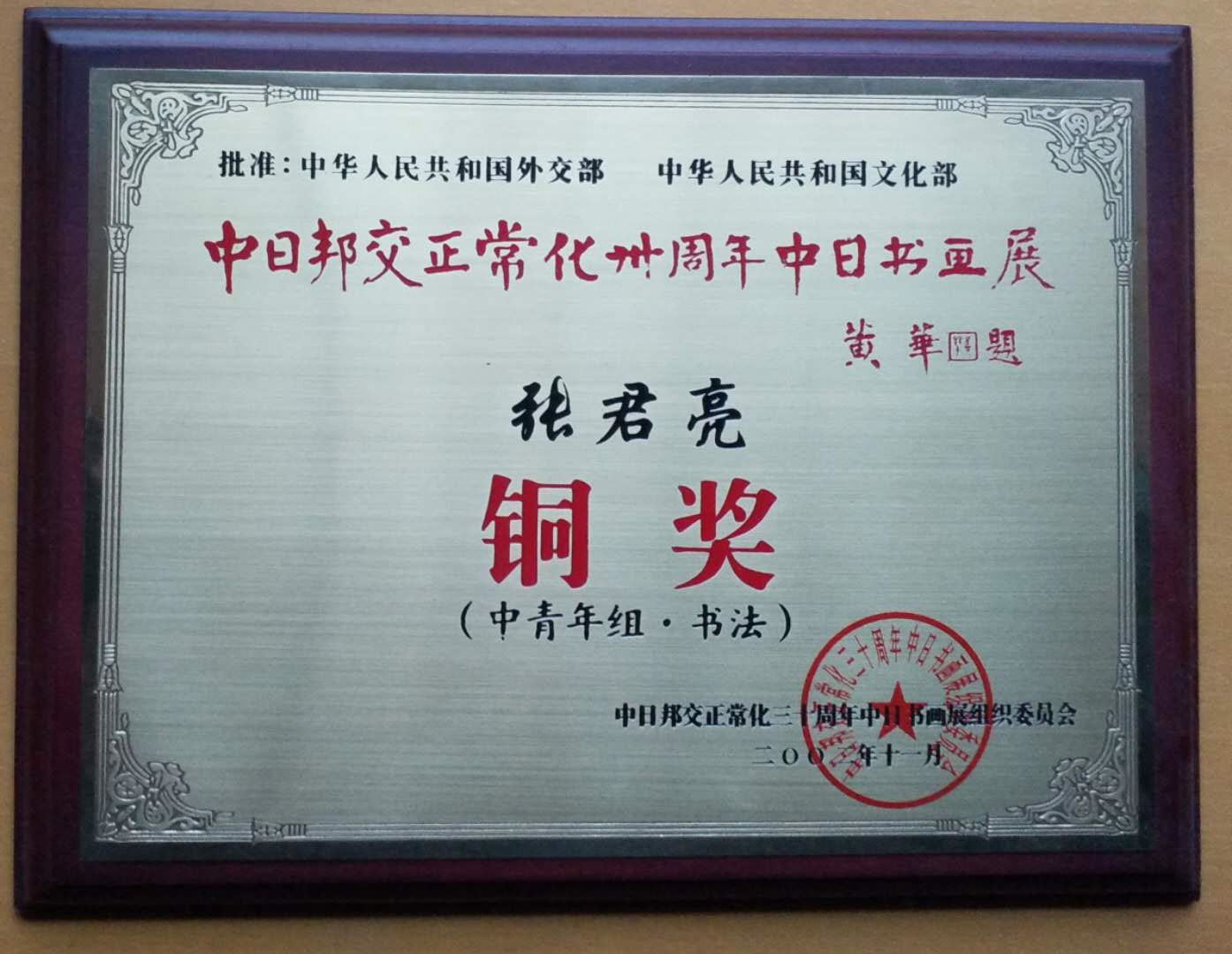
通过大量的研习古人的碑贴和书法理论,他以一个军人独到的目光锁住了“锥划沙”三个字。他认为中国书法的精髓就“锥划沙”三字。是后人们把书法弄复杂了,神乎得近于了玄学。”张君亮为了练习锥划沙的用笔力度先是把自己的书案的四个腿锯去了一大截。迫使自己每天得像大虾一样地躬在那里写字。又到安徽的毛笔厂家专门定制了三寸长峰的羊毫毛笔。这些年来张君亮练习书法用过的毛笔就清理出去好几塑料袋。
Through a large number of studies on the ancient stele and calligraphy theory, he locked the three words "cone and sand" with the unique eyes of a soldier. He thinks that the essence of Chinese calligraphy is "cone strokes sand". It is the later generations who have complicated calligraphy and are close to metaphysics. " Zhang Junliang saw his four legs of his book case to practice the strength of his brush in order to practice the sand cutting. Force yourself to bow down there every day like a shrimp to write. Also to Anhui brush manufacturers have customized three inch long peak of the sheep hair brush. Over the years, Zhang Junliang has used brush to practice calligraphy and cleaned out several plastic bags.

功到自然成,十年苦练,一鸣惊人。在中国第六届书法篆刻展览会上他的草书和篆书两幅作品同时入选之后,他的作品又相继参加了全国第一届扇面书法大展;全国第二届楹联书法大展;现代国际临书大展;中国书协会员优秀作品展;23届中国兰亭书法节百名群贤展;全军中国书协会员优秀作品展;全军第三届书法篆刻展览;全军中国书协会员优秀作品展;纪念孔子诞辰2550年书法大展;西泠印社首届扇面书法大展。
It is a wonderful ten years of hard work. After his two works of cursive script and seal script were selected at the sixth Chinese calligraphy seal cutting exhibition, his works successively participated in the first fan calligraphy exhibition in China; the second couplet calligraphy exhibition in China; the modern international book exhibition; the excellent works exhibition of the members of the Chinese Calligraphy Association; the 100 famous group sages exhibition of the 23 Chinese Lanting Calligraphy Festival; the outstanding works exhibition of the members of the Chinese Calligraphy Association of the whole army; The third calligraphy seal cutting exhibition of the whole army; outstanding works exhibition of members of the Chinese Calligraphy Association of the whole army; the exhibition of calligraphy in commemorating Confucius' birth in 2550; and the first fan calligraphy exhibition of Xiling printing society.

在“华天杯”首届全军业余电视书法大赛等39次全国全军书法展赛中获等级奖。有三百多件作品在《中国书法》《书法》《书法报》《书法导报》《青少年书法报》等多家报刊杂志上发表。《人民日报》《解放军报》《新闻与成才》《中华名流》等20多家新闻媒体对他的自学成才的事迹进行过专题报导。
He won the grade award in 39 national calligraphy exhibitions such as the first amateur TV calligraphy competition of the whole army in the Huatian cup. More than 300 works have been published in many newspapers and magazines such as Chinese calligraphy, calligraphy, calligraphy, calligraphy guide and Youth Calligraphy. More than 20 news media, such as people's daily, PLA Daily, news and talent, and famous Chinese celebrities, have reported on his self-study achievements.

谈到这些年他在书法上取得的成就,张君亮先生说:这主要得益于专、恒、勤、思四个字。
Referring to his achievements in calligraphy in these years, Mr. Zhang said: This is mainly due to four words of specialization, perseverance, diligence and thinking.
“专”是锁定一个书法目标,心不二用,刚当兵那阵子,部队领导让他当卫生员。他干了一阵子觉得这个行业专业性太强,不专心投入就不能像白求恩那样精益求精。于是他找领导硬是把这个人人眼热的岗位换给了搞勤杂的,为的就是能专心书法。
"Special" is to lock a calligraphy target, with no use in mind. Just when he was a soldier, the army leader made him a health officer. He felt that the profession was too professional for a while, and he couldn't keep improving as Bethune had been without concentration. So he asked the leader to change the hot position for the hard work, so that he could concentrate on calligraphy.
“恒”,就是持之以恒终生不渝。
"Persistence" means that we will keep going forever.
“勤”,就是每天都要练字,并规定出书法的目标,一个时期有一个时期的目标。
"Diligence" means that every day, calligraphy should be practiced and the goal of calligraphy should be set. There is a period of goal in a period.
他的“思”字用得最为得益,出生在孔子之乡的张君亮深知“学而不思则罔”的道理。他通过对中国书法发展历史的系统研究,得出结论:学习书法要不重名人重名贴。因为名人的成果都是结集在名贴里的。
His word "thought" was most beneficial. Zhang Junliang, born in the hometown of Confucius, knew the truth that "learning without thinking is not good". He has made a systematic study of the history of Chinese calligraphy development, and concludes that learning calligraphy should not emphasize celebrity and name affidavit. Because the celebrity achievements are all gathered in the famous post.
他的“思”字用得最为得益,出生在孔子之乡的张君亮深知“学而不思则罔”的道理。他通过对中国书法发展历史的系统研究,得出结论:学习书法要不重名人重名贴。因为名人的成果都是结集在名贴里的。
Zhang Junliang, who was born in the hometown of Confucius, knows that "learning without thinking is useless". Through a systematic study of the development history of Chinese calligraphy, he came to the conclusion that the study of calligraphy should not attach importance to celebrities and name stickers. Because the achievements of famous people are gathered in the famous posts.

中国历史上的书法家大致有这样的四种人:官家,像二王,颜真卿,宋徽宗,郑板桥等。第二种是文人墨客,如玄永,米芾,黄山谷,齐白石,吴昌硕等。第三种是僧侣道士,像怀素,智永,弘一法师等。第四种是民间的无名氏,从汉简帛书到石鼓碑刻。而这些又恰恰是中国书法艺术发展的不竭源头。
There are four kinds of calligraphers in Chinese History: officials, such as Erwang, Yan Zhenqing, song Huizong and Zheng Banqiao. The second is the literati, such as Xuanyong, Mi Fu, huangshangu, Qi Baishi, Wu Changshuo, etc. The third is monks and Taoists, such as huaisu, Zhiyong and Hongyi. The fourth is the anonymous people, from Han bamboo and silk books to stone drum inscriptions. And these are exactly the inexhaustible source of the development of Chinese calligraphy art.
他喜欢的名贴有王羲之的《兰亭序》《黄庭经》;王献之的《中秋贴》和《鸭头丸》贴;怀素的《自叙贴》;《龙门造象》;西周的《散氏盘》;北魏碑文。为了研究古人碑贴上的笔法,他常用放大镜去观察贴上笔末毫端的用笔变化。体味古人用笔的细心与谨慎。在书法理论上他也是众采百家之说而成独特之势。他看到杜甫有“书贵瘦硬方有神”的诗句,就苦练线条的硬度,后来在一家葡萄园看到葡萄藤蔓緾扭的弹性大受启发。于是在自己瘦硬线条的基础上又注入了钢筋般的弹力,把篆书融入行草之中,使他的作品形成了外延充满沉稳刚毅和内凝蓄势张力欲发的风格。
His favorite names include Wang Xizhi's preface to Lanting and huangtingjing; Wang Xianzhi's Mid Autumn Festival paste and Yatou pill; huaisu's self narration paste; Longmen's statue; Sanshi pan of Western Zhou Dynasty; and inscriptions of Northern Wei Dynasty. In order to study the technique of writing on ancient steles, he often used a magnifying glass to observe the change of the writing style at the end of the pen. Appreciate the carefulness and prudence of the ancients. In the theory of calligraphy, he also adopted the theory of "a hundred schools of thought" and became a unique trend. When he saw Du Fu's poem that "books are expensive, thin and hard, there is a God", he practiced the hardness of the lines. Later, he saw the elasticity of the vines in a vineyard, which was greatly inspired. Therefore, on the basis of his own thin and hard lines, he injected steel like elasticity, and integrated the seal script into the running grass, so that his works formed a style full of stability and firmness, and a style of potential tension.

近几年来,张君亮的书法作品越来越被国内外的书法名家和收藏家所关注。原中国书法家协会主席沈鹏先生鼓励其出版作品集。并亲笔题写了《张君亮书法作品集》书名和《张君亮书法展》。张君亮的书法也受到了当代各方面的关注。特别是军队里的很多将军都喜欢收藏他的作品。在毛泽东主席诞辰一百一十周年时,张君亮应毛泽东儿媳邵华之邀为之写了一幅作品,被毛岸青和邵华一家收藏。毛岸青、邵华、毛新宇亲笔签名给他来信表示感谢。同时还给汇来了二千元钱。张君亮把钱退了回去。他说我是怀着对毛主席他老人家的一片真情写的,哪能收钱。
In recent years, Zhang Junliang's calligraphy works have been paid more and more attention by famous calligraphers and collectors at home and abroad. Mr. Shen Peng, former chairman of the Chinese Calligraphers Association, encouraged him to publish his works. He also wrote the title of "Zhang Junliang's calligraphy works collection" and "Zhang Junliang calligraphy exhibition". Zhang Junliang's calligraphy has also been concerned by all aspects of contemporary. In particular, many generals in the army like to collect his works. On the 110th anniversary of Chairman Mao Zedong's birth, Zhang Junliang, at the invitation of Mao Zedong's daughter-in-law Shao Hua, wrote a work for him, which was collected by Mao Anqing and Shao Hua's family. Mao Anqing, Shao Hua and Mao Xinyu signed a letter of thanks to him. At the same time, we also remitted 2000 yuan. Zhang Junliang returned the money. He said that I wrote it with the true feelings of Chairman Mao and his old people. How can I collect money.
现在张君亮的所在部队整编安排他退养,他每天除持之以恒地写几百字书法外,就是到楼下的小园里耕耘他那几垄菜园子。访问结束时他领我看了他的菜园,此时正是刚过立秋时节,天很蓝,云也很白。
At present, Zhang Junliang's army reorganizes and arranges him to retire. In addition to persistently writing hundreds of words and calligraphy every day, he goes to the small garden downstairs to cultivate his several rows of vegetable gardens. At the end of the visit, he showed me his garden. It was just after the beginning of autumn. The sky was blue and the clouds were white.
在他的庭院里我一下子体会到了当年陶渊明“种菊东篱下,悠然见南山”的那种平和的心态。
In his courtyard, I suddenly realized Tao Yuanming's peaceful mentality of "planting chrysanthemums under the eastern fence, leisurely seeing Nanshan".

郝连成2008年秋采写于佳木斯驻军守备八师
Hao Liancheng wrote in the eighth garrison division of Jiamusi in autumn 2008








0 条 评 论 Write a Response